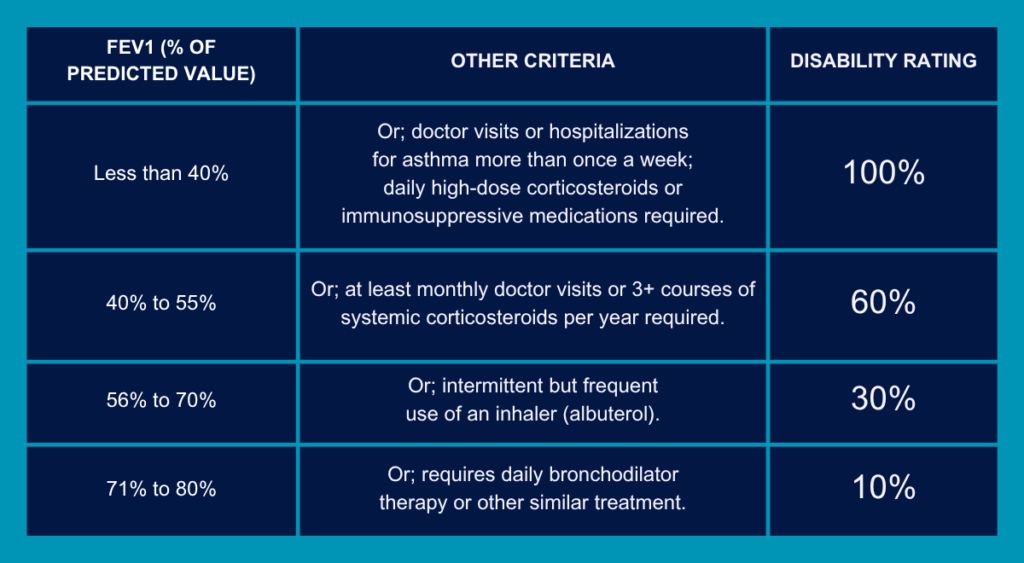It can feel like you’re trying to breathe through a straw. That tightness in your chest, the wheezing, and the constant worry about your next asthma attack can be exhausting. On top of it all, you have to fight another battle with paperwork just to get the disability benefits you earned.
Filing an asthma VA claim? See how pulmonary function tests nexus letters and strong evidence prove service connection. It can seem overwhelming, but you’re not alone in this fight to get the VA benefits you deserve for your respiratory condition.
You served your country, and you were exposed to things that might have caused or worsened your breathing problems. Now it’s time to get the compensation you deserve from your VA disability claim. This guide will walk you through building a strong asthma claim, because you need to know how to connect the dots for the VA.

What Does ‘Service Connected’ Even Mean for Asthma?
Before gathering evidence, you need to understand what the VA is looking for in a disability claim. They use the term “service connection” to confirm your military service caused or worsened your condition. Think of it like a three-legged stool; if one leg is missing, the whole thing falls over.
The three legs for a service-connected disability are a current diagnosis of asthma from a medical professional, an event in service that could have caused it, and a medical link connecting the first two. You must prove all three elements for the VA to approve your claim. There are a few ways the VA recognizes this connection for your asthma claim.
Direct Service Connection
This is the most straightforward path to receiving benefits for a service-connected condition. You were diagnosed with asthma while you were still in the military. Your service treatment records would show visits to sick calls for breathing trouble or an official asthma diagnosis.
Maybe you were fine before you enlisted but started having attacks after a training exercise in a dusty environment. If that’s documented in your military medical records, you have a strong case for a direct service connection. These records are the foundation of your claim.
Secondary Service Connection
Sometimes one health problem can lead to another, creating secondary conditions. Let’s say you have a service-connected disability for GERD, where stomach acid frequently comes up into your throat. That acid can irritate your airways and lead to or worsen asthma.
In this case, your asthma is a secondary condition to your GERD, which is the primary service-connected disability. You would need a doctor to provide a medical nexus stating that your service-connected GERD is causing your asthma. It is also common for veterans with rhinitis or sinusitis to develop asthma as a secondary service connection.
Another related issue is obstructive sleep apnea. Some studies suggest a link where conditions like asthma can contribute to or worsen sleep apnea secondary to the respiratory distress. Proving this link is crucial for establishing secondary service connections.
Service Aggravation
What if you had mild asthma as a kid, but it got much worse in the service? This is called aggravation. You need to show that your condition was made permanently worse by your service, beyond its natural progression.
For example, if your childhood asthma was minor but became severe after exposure to burn pits in Iraq, that’s aggravation. The VA needs to see a clear increase in severity that’s tied to your military duties. Medical opinions and records showing your pre-service condition compared to your current state are critical here.
Why Your Evidence Is Everything
The VA operates on evidence, plain and simple. They need documents, medical test results, and expert opinions to approve your VA claim. The person reviewing your file doesn’t know you or what you went through during your service.
You have to paint a clear picture for them with strong proof. Every piece of evidence you submit is a building block for your case and helps you get the correct VA disability rating. A claim with very little evidence is almost certain to be denied.
Your main job is to gather as much high-quality evidence as possible to support your VA disability claim. It might seem like a lot of work, but it’s the most important thing you can do for your claim’s success.

Let’s Talk Pulmonary Function Tests (PFTs)
If you’re filing for asthma, you will hear about Pulmonary Function Tests, or PFTs. This is the main test the VA uses to see how well your lungs are working. It’s an objective measurement of your breathing, so the results carry significant weight in the claims process.
You’ll breathe into a machine called a spirometer that measures how much air you can breathe in and out, and how fast you can do it. This isn’t just a simple test; it gives the VA hard numbers to assign disability ratings. These tests are essential for any respiratory conditions you claim.
What Do PFTs Actually Measure?
The PFT machine looks at a few key numbers, and understanding them helps you understand your claim. These are the main results the VA cares about when determining VA rates for asthma. You will see these values expressed as a percent predicted for your age and height.
One is the Forced Expiratory Volume in 1 second, or FEV1. This is the amount of air you can force out of your lungs in the first second of a hard exhale. For people with asthma, this number is often lower because their airways are narrowed, a classic sign of obstructive or restrictive lung disease.
Another is the Forced Vital Capacity, or FVC, which measures the total amount of air you can forcefully breathe out after taking your deepest breath. The ratio between your FEV1 and FVC helps doctors diagnose obstructive lung diseases like asthma.
How PFT Results Translate to a VA Rating
The VA takes your PFT results, specifically the FEV1 value, and compares it to what would be normal for a peer of your age, height, and gender. The lower your FEV1 percentage is compared to the predicted value, the higher your potential asthma va rating. The VA also looks at how much medication you need to control your asthma symptoms.
According to the VA’s rating schedule under diagnostic code 6602, asthma VA ratings are generally assigned as follows:

As you can see, those test numbers directly impact the VA disability benefits you could receive. That’s why getting an accurate PFT from a medical professional is so important. A higher rating leads to higher VA rates for your disability.
Connecting Your Asthma to Your Service
Your PFTs give the VA a picture of your current lung function. But you still need to connect that breathing problem back to your time in the service. This is where a nexus letter becomes one of your most powerful tools.
Think of it as the final piece of the puzzle for the VA claim expert reviewing your file. It’s the one document that explicitly links your diagnosis to your military service, and it’s written by a medical expert. This medical nexus is often the key to winning your case.
The Power of a Strong Nexus Letter
So what is a nexus letter? It’s a medical opinion written by a qualified doctor that states your asthma is related to your time in the military. The letter acts as a bridge for the VA rater, making their job easy to connect the dots and grant service connection.
Without a clear nexus, the VA may agree you have asthma and that you served, but they might decide the two aren’t related. A well-written letter from a doctor can prevent that from happening. It’s a critical piece of evidence for your VA claim.
It’s best to get a nexus letter from a specialist, like a pulmonologist, who can offer an expert-level VA opinion. Their expert opinion carries a lot of weight. They can review your entire file and provide a reasoned medical explanation that the VA has to consider.
What Makes a Nexus Letter Compelling?
Not all nexus letters are created equal. A great one will be detailed and based on solid medical reasoning. It should clearly state that the doctor has reviewed your service and medical records.
Most importantly, it needs to use the right language. The VA looks for phrases like “it is at least as likely as not” that your condition was caused or worsened by your service. This is the legal standard of proof the VA uses, which means there’s a 50% chance or greater.
A strong letter explains the “how” and “why” behind your service-connected asthma. For example, it might say, “After reviewing this Veteran’s records showing exposure to dust storms in Afghanistan and his subsequent development of respiratory symptoms, it is my professional opinion that his current asthma is at least as likely as not a result of his military service.”
Building Your Evidence Locker: What Else You Need
A solid PFT and a killer nexus letter are your heavy hitters. But you should support them with more evidence. The more proof you have, the harder it is for the VA to deny your claim for disability benefits.

Your Service and Medical Records
This is foundational to any VA disability claim. You need your DD 214 to prove your service details. Go through your Service Treatment Records with a fine-tooth comb for any mention of coughing, shortness of breath, or inhaler prescriptions.
Don’t forget your post-service records from private doctors or VA medical centers. Gather every note from your family doctor or VA specialist about your asthma. This shows the VA that you’ve been consistently getting treatment for your condition since you left the service.
Lay and Buddy Statements
Statements from people who know you can be surprisingly powerful. This type of lay evidence is submitted on a specific VA form. Your spouse, a friend from your unit, or a family member can write about how your asthma affects your daily life.
They can describe watching you struggle for breath, seeing you use your inhaler constantly, or how you can no longer do things you used to enjoy. These personal accounts help humanize your claim and show the real-world impact of your condition. Use VA Form 21-10210 for these statements.
A Personal Statement
Nobody knows your story better than you do. Writing a personal statement can fill in gaps that your medical records don’t cover. Tell the story of your breathing health before, during, and after your service.
Be honest and direct. Explain when your symptoms started, what you were doing or where you were when it happened, and how it has changed your life. This is your chance to speak directly to the VA rater and make your case in your own words.
The PACT Act and Your Asthma Claim
For many veterans who served after 9/11, the PACT Act has been a game-changer for respiratory conditions. This law recognizes that exposure to toxins like burn pits in certain areas is linked to specific health problems, including asthma. This creates a more direct path to getting your claim approved through presumptive service connection.
Is Your Asthma a Presumptive Condition?
Under the PACT Act, the VA now presumes that your asthma is service-connected if you have a current diagnosis and served in a specific place during a specific time. You don’t need to prove an in-service event caused it; the burn pit exposure is assumed. This makes getting service-connected asthma much easier for many veterans.
This presumptive service applies to veterans who served in places like Iraq, Afghanistan, Kuwait, Saudi Arabia, Somalia, Syria, and more after August 2, 1990. The list of locations and dates is long, so it’s worth checking to see if your service qualifies.
Even with a presumptive condition, you still need that current diagnosis. You will also still need evidence like PFTs to show the severity of your asthma so the VA can assign the correct VA rating and provide the appropriate VA rates asthma deserves.

Asthma and Total Disability Individual Unemployability (TDIU)
What happens when your asthma is so severe it prevents you from working, but your rating is less than 100%? You may be eligible for Total Disability Individual Unemployability, or TDIU. This VA program allows you to receive compensation at the 100% level if your service-connected conditions prevent you from maintaining a steady job.
For a TDIU claim, you must demonstrate how your service-connected asthma impacts your ability to work. For example, frequent asthma attacks might lead to missed workdays. Exposure to common workplace irritants could trigger your symptoms, making many job environments unsafe for you.
Proving a claim for total disability individual unemployability requires strong evidence. You’ll need medical records, employer statements, and a personal statement explaining your work history and limitations. Achieving total disability status through TDIU can provide significant financial stability when you can no longer work.
Conclusion
You can see how all these pieces fit together to build a strong VA disability claim. You have to show the VA that you have asthma now, that something happened in service to cause it, and you need a doctor to link the two. Strong medical evidence, especially objective tests like PFTs, is your best friend in this process.
A powerful nexus letter can be the final element that gets your claim approved, while presumptive service connection through the PACT Act can simplify the path. Backing all of that up with buddy statements and your personal story creates a complete package. Building a successful case when Filing an asthma VA claim? See how pulmonary function tests nexus letters and strong evidence prove service connection. is about being prepared and thorough.

